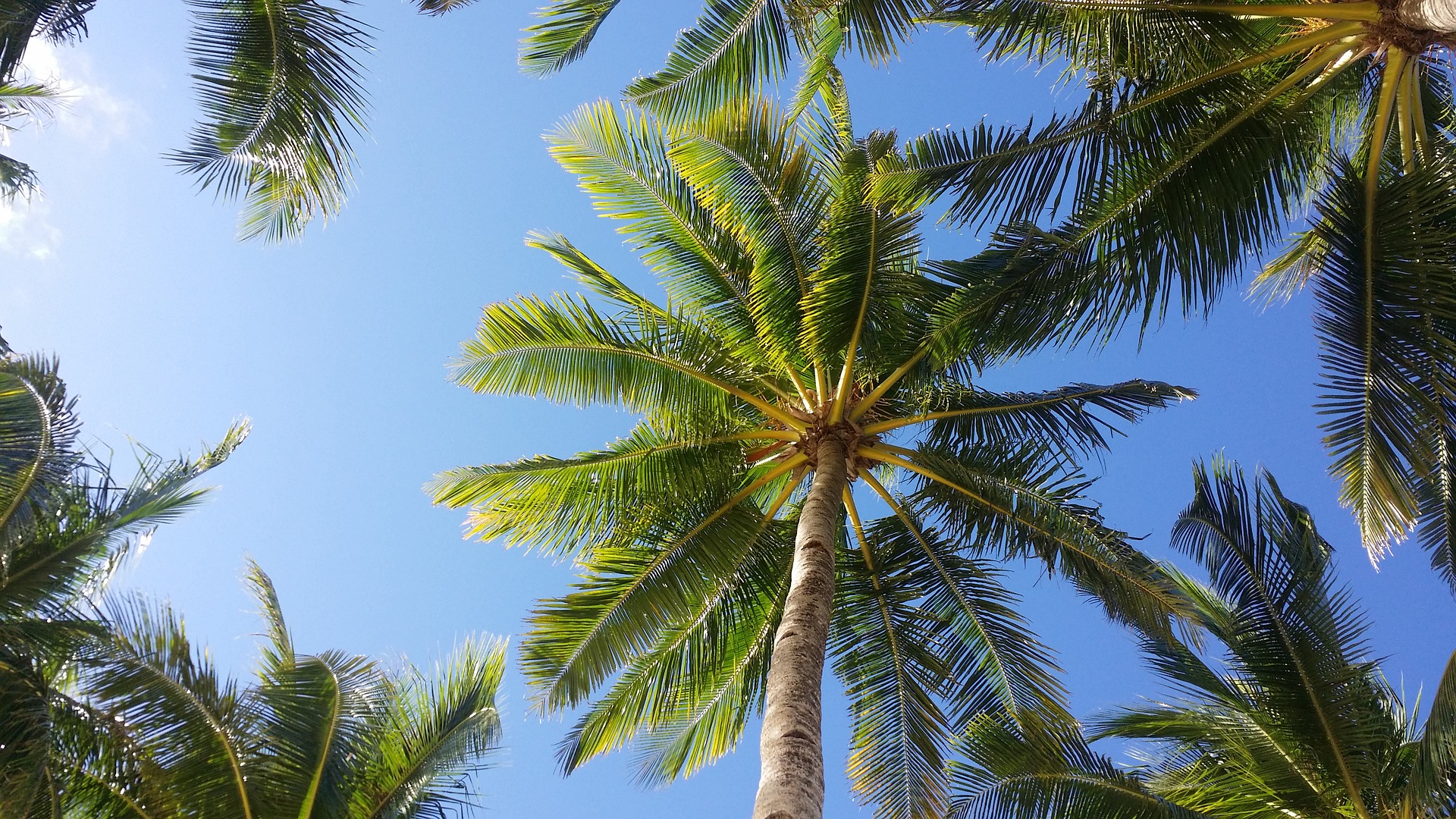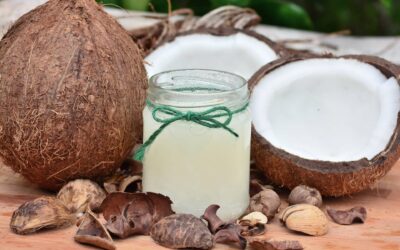A General Overview of the Palm Oil Industry and the Top Major Players
The Palm oil industry can be traced back about 5000 years ago when archaeologists discovered palm oil in a tomb at Abydos which was believed to have been brought in by traders to Egypt around 3,000 BCE.
The palm oil which is normally derived from the E. guineensiss which grows wild in the tropical West and Central African countries and was mostly used as a cooking oil until European traders started purchasing the palm oil to be used for cooking in Europe.
Palm oil even gained more grounds in the market during the Industrial Revolution in Britain and British traders purchased the oil which was used as a lubricant for types of machinery.
Palm oil export constituted the main exporting commodity for African countries like Ghana and Nigeria during the early 1870s. However, the South Asians countries like Indonesia, Malaysia, and Thailand are the leading exporters of Palm Oil in the world as of Now.
Presently, Indonesia and Malaysia are the world’s largest palm oil producers, accounting for 85% of world palm oil production. With Thailand accounting for 4% of world palm oil production. In 2011, palm oil production provided more than 53 million metric tons of palm oil from 16 million hectares of land, which was produced by Indonesia and Malaysia (86%), with palm oil being the main financial economic driver and an important component for GDP.
In the past 50 years, palm oil has achieved amazing and predictable progress throughout the market. This is being driven by the increasing demand from importing countries like , China not leaving out the member states of EU.
Today, palm oil is the most sort after commodity for huge soap companies like Unilever and American Palmolive brand. Palm oil has been recognized as the most used vegetable oil in the world, with a total yield of up to 40% compared to other vegetable oils.
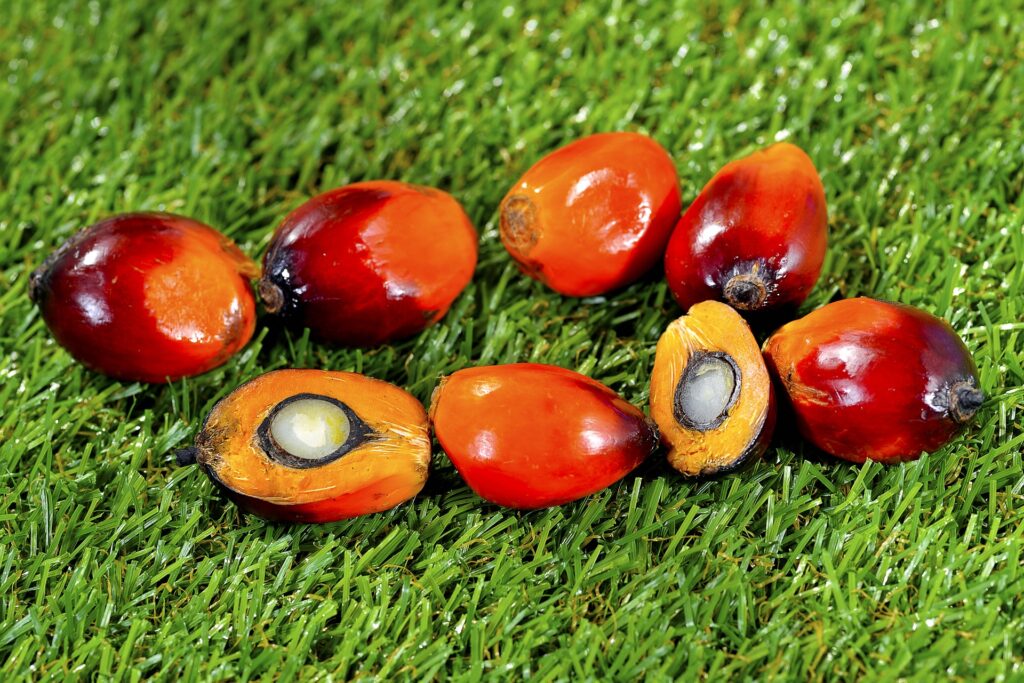
World Palm Oil Production In 2017
- Indonesia (Production per 1000MT)41,000.00
- Malaysia (Production per 1000MT) 23,000.00
- Thailand (Production per 1000MT) 2,200.00
- Colombia (Production per 1000MT) 1,320.00
- Nigeria (Production per 1000MT) 970.00
- Other Countries (Production per 1000MT) 5,365.00
The broad improvement of oil palm ventures in numerous nations in the tropics has been inspired by its high degree of productivity potentials. The oil palm gives the most productive yield in terms of oil produced per unit of hectare or area which when compared to other crops it is outstanding and more special as it produces two types of oils (The palm oil and the Kernel oil) – the two of which are imperative in world exchange.
Palm Oil An Overview
Palm oil is derived from the fruits of the “Elaeis guineensis” also known as the mesocarp which is reddish-pulp in nature. There exist other oil palms like the American “Elaeis oleifera” and the “Attalea maripa” of the maripa palm. However, these other palms are being used for the production of palm oil in a lesser extent compared to the “Elaeis guineensis” with origin from West Africa.
The oil palm tree produces bunches of fruits which weighs around 10-25 kgs in some cases. At the early stages, the fruits are seen to be dark purple and close to in color with a spherical or elongated shape. At maturity, the fruit’s color changes to an orange-reddish color and weighs about 6 -20 gms per fruitlet. The oil palm trees are favorable within 10° tropical climate regions of the equator with high rainfalls not less than 1600 mm/yr.
The trees can grow to about 60 feet and bears fruits after 30 months after planting. The oil palm tree can remain productive for over 20 – 30 years. Palm oil is reddish in color due to the high level of carotene content. As mentioned earlier, two types of oil are derived from the oil palm fruit which it more . The difference between the palm oil derived from the “mesocarp” and the palm kernel oil derived from the seed covered with a hard shell is the presence of carotenoids and the saturated fat level. The palm kernel oil lacks carotene and contains 81% to 86% saturated fat level. Whereas, the oil palm from the “mesocarp” only contains 49 % saturated fat level.
From every bunch, about 17 to 27% of palm oil can be obtained and about 4 to 10% for the palm kernel oil.
Palm oil is semi-solid under room temperature and it is widely used for cooking in South East Asia, West Africa, and in major parts of Brazil. The reason for the widespread usage of palm oil is due to the commercial value for the oil and its high oxidative stability of the oil, especially when used for frying. This has pulled numerous fast food stores towards the usage of palm oil for frying French fries, potatoes, and doughnuts. In 2015, it was concluded that human consumption of palm oil is estimated to an average of 7.7 kg per person.
Palm oil production was estimated at a 59.9M tons in 2015 and 62.6M tons in 2016 which mark a 2.7M Increased in production. The market brought in about $36.9B in 2015 and $39.3B in 2016 respectively. These values indicate a 7% increase in value ($2.4B) during this period. Production of palm oil has only known increase. From 1962 to 1982 palm oil production increased from about five hundred tons to 2.4Million tons. Not to mention the year of 2008 where production for palm oil and palm kernel stood at 48Million tons. It is believed that the demand for palm oil globally will double by 2020 and triple by 2050.
The food industry places the highest demand for the world’s palm oil production which covers about 80% of global production. Palm oil is widely used by the food industry as a suitable and healthy replacement to animal fats found in many foods like margarine, chocolates and a variety of other foods containing animal fat. This is due to the high level of nutrient, vitamins and low cholesterol level.
Also, Palm oil is highly used for the production of cosmetics and household products like detergent, soaps, and pharmaceuticals. With the use of palm oil in the production of methyl and biodiesel, new markets are being opened every day. It is also stated 30% of Malaysia’s and 40% for Indonesia’s exportation for palm oil to Europe is used to fuel cars.
Composition Of The Palm Fruit and Content of Palm Oil.
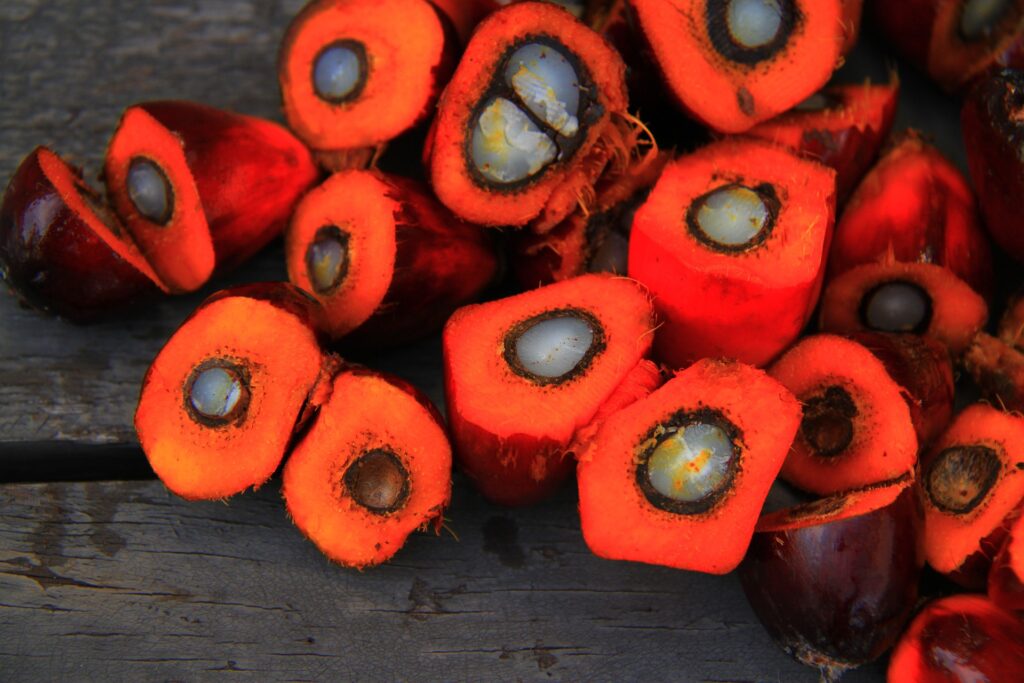
The Ideal composition of a palm fruit is known to be as follows;
Weight per bunch 23-27 kg
Fruit per bunch 60-65 %
Mesocarp per bunch 44-46 %
Oil per bunch 21-23 %
Kernel per bunch 5-7 %
Mesocarp per fruit 71-76 %
Kernel per fruit 21-22 %
Shell per fruit 10-11 %
However, since ideals are sometimes difficult to achieve, the main reason here is attributed to the climatic conditions. In a case of less rainfall, the oil palm tree is faced with water-related issues which greatly determine the outcome of the harvest.
Composition
Palm oil just as any other fats are composed of several types of fatty acids ester compound with glycerol. Palm oil is known to have a typical high concentration of saturated fat like Palmitic acid which signifies where its name originated, the 16-carbon saturated fatty acid. Another major component of the palm oil is the Monounsaturated oleic acid.
Carotenes
The extra dark red color of the unrefined palm oil is due to the presence of Carotenes. These carotenes are made of beta-carotene, alpha-carotene, and lycopene which contributively brings the red color of the palm oil. The presence of carotenes are only characteristics with crude palm oil but when it is processed into refined bleached deodorized (RBD) palm oil, the presence of carotenes are absent.
Vitamin E
Palm oil is known to be rich in vitamin E than any other vegetable oil. The rich nature of vitamin E (tocopherols and tocotrienols) make it a powerful antioxidant.
The Production Process Of Palm Oil
One extraordinary characteristic of the palm fruit is how it can be used to produces two unique sorts of oil – palm oil from the mesocarp, and Palm Kernel Oil from the part of the interior endocarp or the seed inside the palm fruit. Around 1 ton of palm kernel oil is produced for every 10 tons of palm oil. Production of palm oil must be done through specific operations in other to meet the end-users needs and the international norms and standards. The production process starts by extracting palm oil from the fruitlets at the processing plant.
The crude palm oil obtained is not the actual palm oil being sold in the world’s commodity market but it can further be refined to produce a variety of palm products with precision to the required quality. The refined yields can additionally be treated to minimize the production cost which is an advantage as it can reflect on the price on the final end product.
Moreover, The oil can likewise be fractionated through a straightforward crystallization and detachment procedure to produce the liquid olein and a solid known as the stearin fraction with varied melting characteristics. This gives the final product (RBDPO) an incredible potential for various attributes ideal for a wide scope of non-foods and food items.
Products of Palm Oil
RBD Palm Oil; Balance fatty acid composition. Used for bakery fats, biscuits fat, food service frying oil.
RBD Palm Olein; Liquid under room temperature. Used for snack food manufacturers cooking oil
RBD Palm Stearin; Solid at room temperature. Use as pastry fats, kinds of margarine, soap manufacturers
Double Olein (Super Olein); liquid under room temperature. A good replacement for hydrogenated fat, a good resistance to oxidation. Used for frying in the food service industry
Palm Mid Fraction; Solid at low temperature and melts very fast. Used as frying oil, ganache kind of confectionery fillings, biscuit filings.
Double Stearin; hard and easy to flake or powder. Used as soup dry mixes, cake dry mixes.
Mid Stearin; mid-range melting point and used as hard rock for margarine.
Palm Kernel Expeller (PKE); A high source for fibres and minerals which includes phosphorus, copper, zinc, and manganese. Used as animal feeds.
The By-products of the Palm Oil Derived Through Extraction and Refining
During the palm oil production there by-products during the process are not considered as waste but can be considered to be resources for many industries. The by-product obtained from the production of palm oil has been used extensively by a variety of Industries and these by-products have proven to be of vital importance in the realization of the final end product.
The production process of palm oil has experience incremental improvements in other to sort further benefits of the by-products and their far-reaching potentials. This has been a positive step to a sustainable industry and to promote the global competitiveness in the vegetable oil industry. Many organizations today are working towards a zero-waste strategy of the palm oil production process. The availability of by-products can’t be avoided but the effective utilization of these by-products is far more important than to be disposed of as waste.
Another importance for the re-usage of the by-products are seen towards the environmental issue it can cause through pollution. This is largely seen through the disposal methods like in waterways or land fields.
The by-products from the palm oil industry can be categorized in Solid by-products, refining by-products, and aqueous by-products.
Solid by-products
The solid by-products may be used as biomass such as the palm pressed fibers (PPF), Shells (palm kernel shell), empty fruit bunches (EFB) EFP from utilizing methane from palm oil mill effluent (POME) which are composed of cellulose, lignin, hemicelluloses, and some other carbonaceous materials. Majority of these by-products are characterized by a high level of organic materials which makes them very useful.
Refining by-products
The refining by-product includes the refined palm oil (RPO) and the palm oil fatty acid distillate (PFAD) which is obtained through de-acidifying and deodorization of crude palm oil (CPO). Also, not forgetting the palm kernel oil (PKO).
Aqueous by-products
Besides refining and solid by-products also exists the aqueous waste produced by the production mills. These production waste has been used as fertilizers and animal feeds. Now our days, POME is used to obtain phenolic antioxidants with high bioactive compounds. These aqueous by-products are highly used in pharmaceuticals, nutraceutical and cosmeceutical industries

By-products and their uses
Empty fruit bunches (EFB); Carboxymethylcellulose (CMC)Cellulose and lignin, Fibre and Particle boards
Aqueous by-products; Fertilisers, Animal feed, Phenolic antioxidants
Palm pressed fibers (PPF); De-oiled fibers, Burnt as fuel, Fibre composite, Pulp and paper, Adsorbents, Incorporated in stone mastic asphalt, Extractable carotenoids, vitamin E, squalene, phenolics, phospholipids and sterols from fiber oil for use in Nutraceuticals, Pharmaceuticals, Cosmeceuticals
Palm fatty acid distillate (PFAD); Squalene, Phytosterols, Tocopherols, Tocotrienols
Shells; Charcoal briquettes
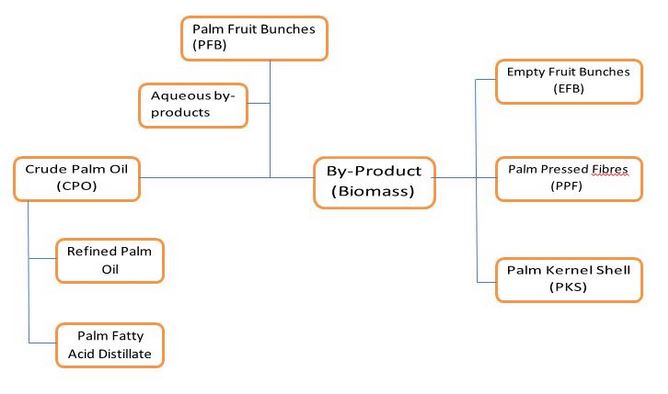
Industries Using Palm Oil.
Both palm oil and Palm kernel components are used in over 50% of the products we buy in our supermarkets today. This is not only limited to food items, but also non-food items. Many people think palm oil is only used for frying in our fast food service restaurants.
The use of palm oil and palm kernel is highly flexible and in a variety of ways simply because it can be blend to attain a wide range of products with different characteristics.
Palm oil and palm kernel based ingredients are used in the following industries;
- Food Service Industry
- Industrial
- Pharmaceutical
- Animal feed
- Biofuel and energy
- Personal care, Cosmetics
- Consumer retail food manufacturers (Snacks)
With a closer look on the labels of products we use almost every day in our life contains some of the following ingredients and parameters which are mostly from palm oil products, by-products, and palm kernel oil;
Laurylamine oxide, Alkylpolyglycoside (APG), Fatty Isethionates (SCI), Caprylic/capric Trigylceride, Isopropylmyristate, Cetyltrimethylammonium chloride, Stearamidopropyldimethylamine, Cocamide MEA (fatty acid-derived) Cocamiede DEA (fatty acid derived), Steareth-2, Laureth-7, Palmityl Alcohol, Octyl Palmitate, Etyl Palmitate, Hydrated Palm Glycerides, Sodium Lauryl Lactylate/Sulphate, Sodium Palm Kernelate, Sodium Kernelate, Sodium Lauryl Sulfate, Sodium Laureth Sulfate, Palmitoyl Tetrapeptide-3, Palmitoyl Oxostearamide, Palm Stearine, Palmitic Acid, Elaeis Guineensis, Stearic Acid, Stearate, Glyceryl, Palm olein, Palmitate, Palmate, Palm Fruit Oil, Palm Kernel Oil, Palm Kernel, Vegetable Fat, Vegetable Oil,
The main importers of Palm Oil
There has been a remarkable growth pace for palm oil exports since 2008 due to the continuous increase in the demand for palm oil. It is believed this increase in palm oil imports wills double and even triple in the nearest future. Palm oil importation has experienced over 15% annual growth in quality from 2013 to 2017. Also, imports reached about 19% of annual growth value in 2017 with close to $40 billion in import revenue. Below is a list of the top importers of Palm oil around the world
India
India currently stands out as the leading importing country for palm oil in the world. India’s imported value for palm oil in 2017 stood at $6.7 Billion with close to 20% import share in the palm oil industry. The total quantity imported by India is over 9 million tons. India’s annual growth rate in palm oil import value was over 20%. India imports its palm oil from the following top 5 markets; Indonesia, Malaysia, Thailand, Philippines, and Papua New Guinea.
China
China comes in second place for the world’s importers of palm oil after India. China has been a key player in the palm oil industry and a strategic market for top palm oil exporters like Malaysia and Indonesia. In 2017, China’s import of palm oil was about 5 million tons with an import value close to $3.5 billion. China’s growth rate in value was about 22% and stands on an import market share of over 10%. China main import markets are; Indonesia, Malaysia, Thailand, Denmark, and Netherlands (In that order)
Pakistan
Pakistan comes in the third position for the world’s import of palm oil. Pakistan’s importation of palm oil has only known increase which lands Pakistan up at the third position on the list of world importers of palm oil. Pakistan imported close to 280 million tons of palm oil in 2017 with an estimated import value of over $2 billion. Pakistan annual growth value has been at 23% with about a 6% share in the world’s palm oil importation. Pakistan top import markets of palm oil include; Indonesia, Malaysia, Singapore, Australia, and Turkey. (in that order)
Netherlands
The Netherlands is at the fourth position of the world Importers of Palm oil. We can also see the Netherlands as one of the leading exporters of palm oil of which She is in the third position in the worlds top exports of palm oil. The Netherlands Imports close to 2.6 million tons of palm oil with an import value close to $2 billion. The annual growth rate for Netherlands Import for 2017 was at 26% with a market share close to 6%. The Netherlands top markets for the importation of palm oil include; Indonesia, Malaysia, Papua New Guinea, Colombia, and Guatemala (in that order)
Spain
Spain imported over 1.9 million tons of palm oil in 2017 comes in at the fifth position for the top world’s importers of palm oil. The imported value for Spain’s import of Palm oil was over $1.4 billion which indicated an annual growth rate of 40% and controls an import market share of over 4.3%. Spain’s top import markets are; Indonesia, Malaysia, Colombia, Papua New Guinea and Netherlands (In that order)
Italy
Italy comes in at the sixth position for the top palm oil importers in the world. Italy imports close to 1.5 million tons of palm oil with a market import value of about $1.1 billion and controls a market share of over 3%. Italy’s import growth rate is at 6% and imports from the following markets with top priority; Indonesia, Malaysia, Netherlands, Colombia, and Honduras (in that order)
United States of America
The United States is at the seventh position of the world’s importers of palm oil. The United States controls over 3.2% share of the world imports of palm oil and imports over 1.4 million tons of palm oil around the world. The estimated import value for the United States Palm oil import is at over $1 billion with an annual market growth rate of 23%. The top markets for United States imports of palm oil include; Indonesia, Malaysia, Ecuador, Colombia, and Singapore (in that order).
Bangladesh
At the eight position of the world’s import of palm oil is Bangladesh. Bangladesh holds a world import market share of 2.9% with an estimated import value of over $998 million. Bangladesh imported over 1.1 million tons of palm oil in 2017 and experienced an annual growth rate of 18% in palm oil importation. Bangladesh’s top import markets include; Indonesia, Malaysia, Singapore, India, and Croatia (in that order).
Germany
Germany steps in at the ninth position for the world’s palm oil importers. Germany’s growth rate in 2017 has been on a decline of -22% but still holds a 2.3% share in worlds import value. Germany imports over 936 thousand tons of palm oil in 2017 with an import value of over $797 million. Germany’s top import markets include; The Netherlands, Indonesia, Malaysia, Honduras, and Italy (in that order)
Egypt
Egypt fits in at the tenth position of the world’s importer of palm oil in 2017. Egypt imports over 780 thousands tons of palm oil with an import value of over $745 million. Egypt holds about 2.2% share in the world’s import of palm oil with an annual growth rate of 210%. Egypt imports its palm oil from the following markets; Indonesia, Malaysia, Korea Republic, Australia and Sweden (in that order)
The Main Exporters of Palm Oil

Indonesia;
Indonesia is the world leader of Palm oil and produces over 41.98 million tons of palm oil in 2017 which marked an 18 percent increase from previous year (2016). Indonesia controls 54.1% of the total market share of palm oil in the World. Production of crude palm oil was at 38.17 million tons and 3.05 million tons for Palm Kernel Oil. The Indonesian Association of Palm Oil Producers (GAPKI) stated the Indonesian palm oil export was at $22.97 billion in 2017. With statistics drawn from GAPKI, it shows Indonesia exports over 26 million tons of just Palm Oil and Palm Kernel Oil. Top 5 Indonesian markets in 2017 include; India, China, Pakistan Spain, and Bangladesh (In that order)
Malaysia;
Malaysia is known to be the second largest palm oil exporter in the world, exporting over 23,974,526 tons of Palm oil and palm oil related products in 2017 with a revenue of over $19.5 Billion dollars as published by the Malaysian Palm Oil Board. Malaysia’s top 5 markets for their palm oil are India, China, Pakistan, Netherlands, and Philippines (in that order). Malaysia holds 28.2 % of the total palm oil market share in the world. Malaysia’s planted area is over 5,811,145 hectares of land in the Peninsular Malaysia, Sabah and Sarawak regions of Malaysia. Malaysia can supply the following palm oil related products; FFB, CPO, Palm Kernel, RBD Palm Oil, RBD Palm Olein, RBD Palm Stearin, PFAD.
Netherlands
The Netherlands is the third largest exporter of palm oil with an estimated export of about 1.4 million tons with a value of 1.2 billion, claiming over 3.5 % market share. The Netherlands has experienced an annual growth in value of 13% from the year 2016-2017. The top five markets of Netherlands palm oil export are Belgium, Germany, France, United Kingdom, and Poland (In that order)
Niger
As of 2017, Niger is the fourth palm oil exporter in World. Niger exports over 280,000 tons of palm oil which generated over $650 million in value exported in 2017. Niger stands to control over 1.9% of the global market share of palm oil with an annual growth rate of 404%. Niger is currently experiencing rapid growth in its palm oil industry and an Increase in demand. Niger top 5 markets are neighboring African countries which include; Nigeria, Benin, Chad, Ghana, and Burkina Faso (in that order).
Papua New Guinea
Papua New Guinea is the fifth global palm oil exporter in the world. The control over 1.5% of the global market share of palm oil and export about 660,000 tons of palm oil to the world. Papua New Guinea generated over $517 million in palm oil export revenue with an annual value growth rate of 33% in 2017. Papua New Guinea’s top export market include; The Netherlands, United Kingdom, Spain, Germany, and Belgium (In that order)
Guatemala
Guatemala comes in at the sixth position of the top palm oil exporters in 2017. Guatemala exported over 714,000 tons of palm oil to the world and holds 1.3 global market share for palm oil. Guatemala palm oil export generated over $440 million with an annual market growth value of 18%. Guatemala top 5 export markets include; The Netherlands, Mexico, Germany, El Salvador, and Nicaragua (in that order)
Colombia
Colombia steps in at the seventh position of the top palm oil exporters in the world. Colombia exports over 553 thousand tons of palm oil and generates over $380 million in export value. The annual growth rate for Colombia’s palm oil in 2017 stood at 55% which shows rapid growth in the palm oil industry in Colombia. Colombia controls 1.1% share in the world’s export of Palm oil. Colombia’s top export markets include; The Netherlands, Brazil, Mexico, Germany, and the Dominican Republic (In that order)
Honduras
At the eighth position is Honduras with a 1% share in world palm oil export. Honduras exports over 470, thousand tons of palm oil to the world with an export value of $344 million. Honduras experienced an annual growth rate of 28% in 2017 and exports to the following countries which makes the top 5 markets for Honduras palm oil market; The Netherlands, El Salvador, Germany, Guatemala, and the United States (In that order)
Germany
Germany exports over 375 thousand tons of palm oil to the world and stands at the ninth position for the global export of palm oil. Germany’s export value was at about $343 million but with an annual growth rate of -4% which indicates a decrease in Germany’s exports market of palm oil to the world. Germany controls over 1% of the market share and exports to Poland, Denmark, The Netherlands, Belgium, and the United Kingdom as its top 5 markets.
Thailand
Thailand stands out at the tenth position with palm oil exportation to the world. Thailand is the third producer of palm oil in the world after Malaysia but 95 percent of Thailand’s palm oil is consumed locally which explains why Thailand only controls 0.6% share in the export market as of 2017. Thailand exports over 310 thousand tons of palm oil with an export value of over $215 million with an annual growth of 429% in 2017. Such rapid growth in market value may suggest an increase in demand of Thailand’s palm oil in the world. Thailand’s top 5 markets include; India, Myanmar, Malaysia, China, and Cambodia (in that order).
The above top 10 exporters of palm oil export hold over 94.2% market share of the total exports for the year 2017. The other countries left out amounted for just a 5.8% market share.
Palm Oil for Biodiesel
There is a remarkable growth and demand of palm oil for the production of biofuels. Fearing the world’s dependence on fossil fuels, many countries insist that a certain percentage of biofuels should be introduced to make palm oil/biodiesel blends. It is estimated 10% of the fuel sold in Europe will be biodiesel by 2020, and 15% for China.
This is due to the fact that palm oil is used to produce both hydrodeoxygenated biodiesel and methyl ester. These palm oil blends for biodiesel is highly desired in the EU region because it meets the EU EN14214 standard biodiesels. The palm oil biodiesel blends are often mixed or fused with other fuels to produce palm oil biodiesel blends in a more efficient way. Singapore currently runs the world’s largest palm oil biodiesel refinery, a 550 million euros plant which was launched in 2011, The Neste Biodiesel plant. Its capacity stands at 800,000 tons per year.
The process for producing the hydrodeoxygenated biodiesel is by direct hydrogenolysis of the fat in propane and alkanes. Majority of the palm oil for the production of the hydrodeoxygenated Biodiesel oil known as NEXBTL comes from the leading exporters of palm oil, Indonesia and Malaysia.
It is also important to note that the after production waste derived after the processing of palm oil can be used for the production of energy. This waste may include the palm shells, the fruit bunches are converted into pellets which are later used up as biofuel. Used palm oil also plays a crucial part in the production of methyl esters. If properly treated with chemical, it can be used to produce biodiesel which is closely comparable to petroleum diesel.
EndNote
The palm oil industry is also being faced with environmental issues due to deforestation for the cultivation of palm trees. This deforestation is triggered by the huge and growing demand for palm oil and related products. This has caused major concerns for the production of palm oil. Many organizations today ensures palm oil production is sustainable as new production strategies are being used. Moreso, organizations are obliged to join the Roundtable on Sustainable Palm Oil (RSPO) in other to meet the requirements of a sustainable palm oil production.


